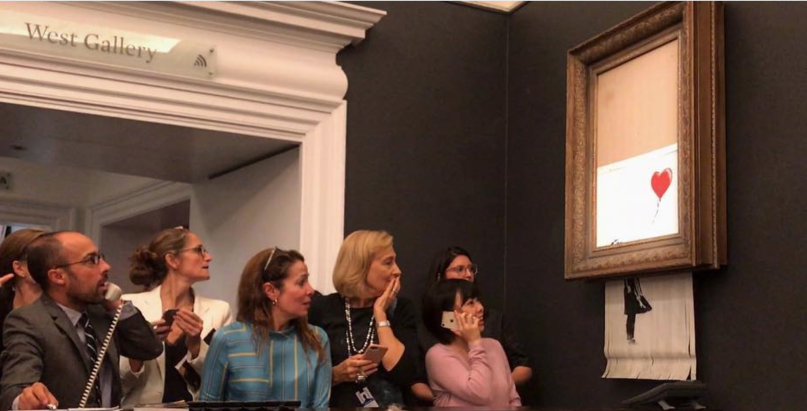4 Things Social Care Professionals can learn from Banksy’s Self-Destructing Artwork

It appears that Banksy’s art work, much like the heart-shaped balloon floating off into the horizon, is increasingly out of reach. The small hands of the nameless girl now seem to represent the longings of the wealthy who, despite their monetary power, were unable to grasp that which they desired.
Now in a state of disrepair, his masterpiece was half-destroyed by a shredder installed at the bottom of the frame just seconds after it was sold for £1m, in one of the biggest plot-twists the art world has ever seen.
For decades, art has increasingly become more and more inaccessible for the many, being stored in cold, marble galleries or exchanged for wild sums of money that most normal people couldn’t even begin to comprehend.
Banksy’s journey began on the streets, free from the obstacles of museum fees, academia and wealth. His art was cost-free and accessible to all. In fact, some would pay not to view his art work, which was once seen as colourful controversy, a nuisance to be cleaned away by local councils. Despite grassroot beginnings, Banksy’s artwork somehow came in to the periphery of the very elite he wished to decry. It seemed sort of weirdly incongruous to see the girl with the red balloon placed in a golden frame, ready to be sold to the highest echelons of artistic society.
As a profession, there is much to be garnered from Banksy’s stunt.
- Be authentic
Under usual circumstances, I wouldn’t encourage using shredders out of the context of, well, shredding…. However, what Banksy did literally shook the foundations of the art world – and the heart of it all, he was being himself. His rebellious, elusive self.
Carl Rodger’s speaks eloquently about the importance of ‘congruence’ in therapeutic relationships. For those who aren’t familiar, that’s a fancy term used to describe being yourself:
‘It means avoiding the temptation to present a facade or hide behind a mask of professionalism’ (Rogers, 1966).
Bring your creativity, quirkiness and imperfections into the room – allow yourself to be human. It’s far better than confirming to the grey humdrum. In doing so, you will give service users the permission to be themselves.
- No one else can determine your value
You can’t really put a price on art; from Michelangelo’s Sistine Chapel Ceiling to heavily worded graffiti you might come across at your local tube station, human creativity breaks the bounds of bonds and bitcoin. Though we do not know this intentions, it is possible that Banksy was willing to slash the value of his masterpiece through his act of destruction (although art critics have differing opinions (Loughery, 2018)).
It is fair to say that social care isn’t the most lucrative of careers, and nobody enters into the profession to get rick quick. It is easy to feel defined by stagnant pay scales, unfair media portrayals and recruitment labels. But just remember that to many vulnerable children and families, a moment of empathy or kindness is invaluable. Your value goes far beyond financial limits.
- Embrace change
The girl with a balloon has been in a state of inertia since 2002. Banksy, on the other hand, may not recognise himself as an artist 16 years on. Sometimes, it’s good to let go of the old and create something entirely different, rather than clinging on to relics of the past.
In social care, embracing change is crucial to surviving in an ever-evolving field. Try not to turn down training even when your schedule is running into 2045. Glean enthusiasm from students who enter the profession with new ideas, skills and knowledge. Ask service users about what makes them tick, and adapt direct work to their learning styles.
- Challenge the system
Banksy’s message remains an enigma. However, my small corner of the world, I see the destructing image as a critique on gender inequality in the arts. According to the Guardian in 2017, female artists only account for 4% of the collections at the National Gallery of Scotland’s collection, 20% of the Whitworth Manchester and 35% of Tate Modern (Ellis-Peterson, 2017). Outrageously, in 2018 a woman is still more likely to feature in a gallery as a the subject of a painted nude rather than the painter (Judah, 2018). In shredding his artwork, some may argue that the girl with the balloon was set free from the frame. A more sombre (but no less true interpretation) would see this act as a representation of how girls across the world are ripped to shreds by violent misogyny, FGM, and quotidian discrimination.
In social care, it is easy to become blind to the injustices inherent within the system. Once you become desensitised to inequality around gender, race and sexuality (amongst many issues), it is easy to become complacent. Which, some may argue, is a form of compliance. If we are truly striving toward a more egalitarian future, we simply cannot continue to rely on other people to make that happen. Because, as the saying goes, If not you, who? If not now, when? – [Hillel the Elder]
References:
Ellis-Peterson, H. (2017) How the artworld airbrushed female artists from history. [Online] https://www.theguardian.com/lifeandstyle/2017/feb/06/how-the-art-world-airbrushed-female-artists-from-history [06/10/2018]
Judah, H. (2018) In 2018 a woman is still more likely to feature as a painted nude rather than as a painter. [Online] https://www.standard.co.uk/lifestyle/esmagazine/in-2018-a-woman-is-still-more-likely-to-feature-in-a-gallery-as-a-painted-nude-than-as-a-painter-a3951406.html [06/10/2018]
Loughery, C. (2018) Banksy artwork ‘doubles in value’ after being shredded in front of stunned buyers at Soetheby’s auction. [Online]. Available from: https://www.independent.co.uk/arts-entertainment/art/news/banksy-artwork-doubles-value-self-destruct-shred-girl-with-red-balloon-sothebys-a8571976.html [06/10/2018]
Rogers, C. R. (1966). ‘Client-centered therapy’, in S. Arieti (ed.), American Handbook of Psychiatry (Vol.3, pp.183-200). New York: Basic Books.




